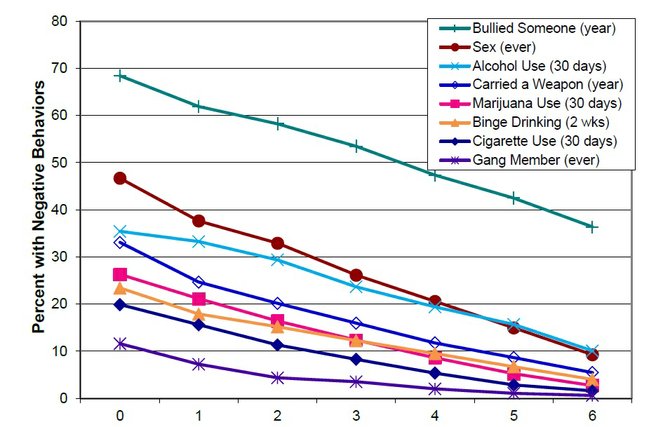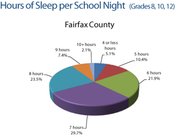The 2010 Fairfax County Youth Survey shows how the presence of at least three "assets" can dramatically reduce the odds of students engaging in risky behaviors such as sex, drug abuse and violent behaviors. Six assets are: high personal integrity, performing community service, being recognized by teachers for good work, having adults in the community to talk to, participating in extracurricular activities and having parents available to help.
First in a three part series.
Periodically, Fairfax County conducts a youth survey which polls thousands of students to get a glimpse into issues of substance abuse, antisocial behaviors as well as factors such as mental health and civic engagements. This is the sixth year the survey has been conducted (the first was in 2001), and in the 2010 Fairfax County Youth Survey was completed by 32,953 students in eighth, 10th and 12th grade, representing 85.6 percent of enrolled students in those grades.
The survey was previously conducted in 2001, 2003, 2005, 2008, 2009 and 2010. Over time, more specific questions regarding risk factors and general health questions have been included. In 2008, the survey was administered in random English classrooms in every school, but in 2009 the county adopted a census-like approach, where all students in the targeted grades were encouraged to participate.
"For the last few years, we’ve conducted the survey every year, because it helps us learn about certain behaviors our youth are doing, and that’s information we can use to plan our prevention efforts," said Marcus Allen of the county’s Department of Neighborhood and Community Services. "The data shows us the way behaviors are trending and we use that for short and long-term planning."
Of the completed surveys, 2,554 were rejected due to fewer than eight questions answered, information was missing, the student reported a use of a fictitious drug called BTM that was mentioned or a student answered "I was not honest at all" on the final question.
The survey itself consisted of 203 questions, which were derived from such sources as the U.S. Substance Abuse and Mental Health Administration’s Communities That Care Youth survey, the Center for Disease Control and Prevention’s Youth Risk Behavior Survey and others.
Photo Gallery
High School Students Discuss Risky Behaviors
The Connection high school interns – Nikki Cheshire (Langley High), Monika Bapna (Marshall High) and Mary Grace Oakes (Madeira) – asked area high school students: What type of risky behaviors do some youth engage in and what do you think poses the greatest risk? Are there certain activities that can lend themselves more to risky behavior because of the nature of the group? Here are their responses.
Click Photo for FlashA PRIMARY FOCUS of the 2010 survey was on "assets" by students, which, according to the survey are "strengths in young people, their families, schools and communities that help them thrive in health, in school and daily life and in a safe environment."
The county polled students on six of these: personal integrity, regular community service, recognition by teachers for good work, having adults to talk to, extracurricular activity participation and having parents available for help.
"We’ve found that the presence of three of these assets dramatically reduces the risk of these students engaging in risky behavior. It’s simple really: the more assets they have, the less likely it is they’re going to engage in these behaviors," Allen said. "It’s not all negative, we want to make sure we’re reinforcing how important these assets are, because it directly affects the likelihood of success."
For example, students with at least three assets are almost half as likely to have had sex, used marijuana in the last 30 days, binged on alcohol in the past two weeks, smoked a cigarette within the last 30 days or joined a gang.
Other risky behaviors such as bullying someone, carrying a weapon and using alcohol within the last 30 days were also reduced by having at least three assets.
Extracurricular activities and civic involvement are two of the assets that students can control. According to the survey, 55.8 percent of students reported being involved in some sort of extracurricular activity once a week, while only 9.2 percent reported never having been involved in an extracurricular activity.
The survey also found that as grade level increases, so does the likelihood of a student getting involved in activities.
Many community groups use the survey to shape their programming and outreach efforts from year to year. Debbie Witchey of the Safe Community Coalition, which hosts programs designed to raise awareness of issues mostly in the Langley and McLean high school pyramids, says it’s a very useful tool to have.
"We look at trends to see what areas of risk are increasing, particularly in areas where the numbers are higher than the rest of the local community or the national average," she said. "We decided a few years ago that the survey was going to be our primary resource when it comes to programming. We feel like it’s quantifiable, empirical data that is very helpful when trying to compare statistics with the rest of the county."
Witchey also said that they make sure to keep the data in context.
"The survey isn’t the be-all, end-all in terms of what we do, we also do exit surveys at all of our programs and make sure we’re keeping in touch with teachers and administrators," she said.
The SCC recently hosted a forum covering all aspects of teen dating violence, and Witchey said that was in response to the data they saw in the survey.
"We were seeing a rise in students that said they were experiencing physical and emotional abuse, and we wanted to make sure we got information out to students, families, parents and school staff so they can be aware of the dynamic," she said. "Often times abuse begins with emotional abuse, which if left unchecked, can lead to physical abuse."
Other findings:
• Nearly seventy percent of students responding report sleeping less than eight hours per night.
• Fifty-four percent said they had been bullied.
• Five percent of teens report physical abuse by a dating partner.
• Twenty-three percent report emotional abuse by a dating partner.
• Thirty-eight percent of 10th graders and 34 percent of 12th graders reported that they have adults in the community they can talk to.
• Thirty-six percent of 12th graders reported consuming alcohol in the past month.
• More 12th graders reported using marijuana (18.9 percent) than reported smoking cigarettes (12.8 percent) in the previous 30 days.
• Thirty-two percent of students surveyed in grades 8, 10 and12 said they had been depressed in the past year.
THE COUNTY has prepared an online toolkit for families, school staff and other community organizations to find resources that will help prevent the risky behaviors identified in the survey and reinforce the importance of assets.
The toolkit can be found online at www.fairfaxcounty.gov/ncs/prevention/toolkit.htm.


